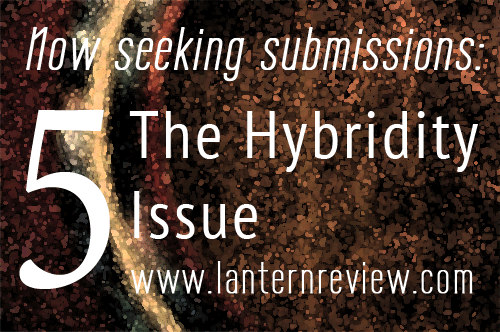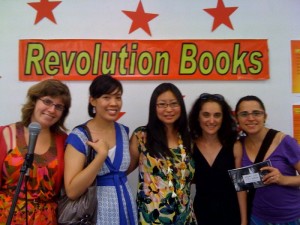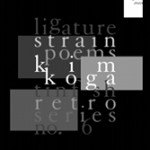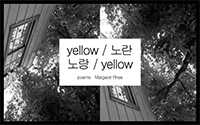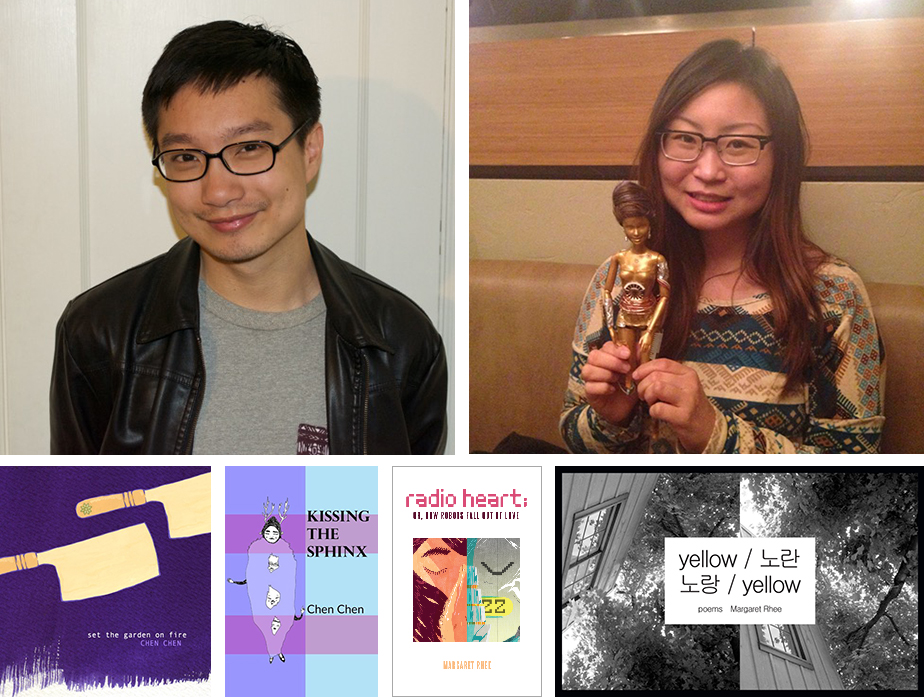
Over the course of this National Poetry Month, we’ve been curating a conversation about Asian American poetry and the book as object. If you’ve been following along with our collaboration with the American Bookbinders Museum these past couple of weeks, you’ll also have noticed our thematic emphasis on the chapbook and its unique relationship to the print traditions of poetry as a genre. Today, in continuation of that discussion, we’re pleased to be able to present a conversation with poet-scholars and two-time chapbook authors Chen Chen and Margaret Rhee. Chen, the author of Kissing the Sphinx (Two of Cups Press, 2016) and Set the Garden on Fire (Porkbelly Press, 2015), and Rhee, the author of Radio Heart; or How Robots Fall Out of Love (Finishing Line Press, 2015) and Yellow (Tinfish Press, 2011), spoke to us about the delights and challenges of the chapbook as a form and shared some of their experiences from the process of shaping and finding publishing homes for their chaps.
* * *
LR: What appeals to you about the chapbook as a form, as distinct from the more traditional format of the full-length poetry collection?
CC: I love that you can read a chapbook in one sitting. I mean, I do that with full-length collections I love, but a chapbook feels like such a good, healthy portion of poetry. You have just enough energy to devour it properly.
I love working with small presses. And I’ve been so lucky. Porkbelly Press did my first chapbook, and I remember giving the editor, Nicci Mechler, all these different ideas for cover art (maybe a train? a moon? a single flower? multiple flowers but not too many?)—and she just knocked it out of the park. I think that’s the first time I’ve said “knocked it out of the park.” Well, written it. I don’t know if I’ve ever said it out loud. I would say it out loud for Nicci Mechler and Porkbelly Press. Those cleavers. That perfect purple. Two of Cups Press did my second chapbook, and we were able to use Lizzy DuQuette’s fabulous image for the cover. I’ve felt so listened to, cared for, by these presses. At AWP this year, Leigh Anne Hornfeldt, the editor at Two of Cups, organized chapbook signings for her authors and a last-minute-but-really-fun joint reading in her hotel room. With both chapbooks, we ran into formatting issues (my lines just got too long!)—both times, the editors knocked it out of the park.
MR: I love the ephemeral nature of chapbooks, how artistic the chapbooks can be, and the possibilities of risk (as poet, as publisher) within the chapbook form.
Moreover I like how chapbooks are not tied to the capitalistic market (as limited as it is for po-biz); there’s something pure about them. This kind of poetry isn’t really about money.
I loved both presses I’ve worked with, Tinfish Press for Yellow (2011), and Finishing Line Press for Radio Heart; or How Robots Fall Out of Love (2015). Both editors, Susan Schultz (Tinfish Press) and Christen Kincaid (Finishing Line Press), paid such close attention to the chapbook as form, and I am so greatly appreciative for the opportunity to work with both of them.
In addition to editing my first chapbook, Susan graciously wrote a blurb for my second chapbook, which also speaks to the generative relationships when working with an editor on a chapbook of poetry. I learned tremendously from Susan and count her as a formative mentor. A precious gift.
LR: Each of your chapbooks has a unique project or conceit that shapes and informs it. Can you describe for us how these projects came about?
CC: For Set the Garden on Fire, I was interested in the child’s voice, the queer child’s voice, the voice of a child of immigrants. So a lot of the poems in this first chapbook wrestle with childhood, early adolescence, and engage coming of age in this very intersectional way. Companion poems like “Write a Letter to the Class About Your Summer Vacation” and “Write a Letter to Your Mother About Your Longest Winter” helped structure the collection—echo and break, circularity as well as surprise, I hope. Flowers and fires, yes, but donuts also play an important role. The chapbook is full of questions about what tenderness means and what kinship or community could look like.
Kissing the Sphinx is much less autobiographical. Or less directly so. I think of it as my chapbook of wacky love poems. There’s a hot air balloon and fuchsia snow pants. There’s Eros and Mariah Carey. One of the speakers makes a trip from Helsinki to Shanghai that I’ve never made. I had to Google how many hours that flight is. The loose arc of the collection goes from early (attempts at) dating to this (attempt at a) more serious relationship. The chapbook wonders, what is “serious” and what is a “relationship”? There is also Tom Daley and a Russian driving instructor.
MR: I’ve spoken before about the project that became Yellow in an interview at Writing Like an Asian:
Yellow was a poetic investigation of . . . [questions] around meaning and difference. But it was also an experiment on poetic form and how formal qualities shape “the racial” and color. The title poem, “Yellow,” was my first conscious attempt to fuse the two (formal + racial) and signaled a turn for my relationship with poetry. . . . [At the time of writing Yellow,] I was inspired by French avant-garde poets of the 1960s such as the Oulipo and Stephane Mallarme, but I was also responding to avant-garde poetry and the privilege of racial omission when utilizing color in poetry, for example. With the exception of “Body Maps,” the poems in the collection were all written within a span of six months and with experimentation as a key focus of writing during that time.
The chapbook is a section of a poetry manuscript I am completing, tentatively entitled “I Love Juana” and Other Poemas, a collection on sex, sexuality, art, activism, race, and protest.
Radio Heart; or How Robots Fall Out of Love came about via various research I was doing on robots and culture for my PhD work at UC Berkeley. At the time, I found that poetry-writing about robots was an interesting way to engage and question demarcations of difference through the science fictional. It was also a reprieve from the scholarly research. In every sense, the robot love relations in Radio Heart are queer relations, but not explicitly so. It was refreshing to take a different turn from my previous writing, which deals pretty centrally with issues of difference (race, class, sexuality) and to explore how science fiction poetry can ask questions on difference, but through worldbuilding. However, I still write explicitly political poetry (Yellow is a section of a poetry manuscript [as mentioned above] I am completing on sex, sexuality, art, activism, race, protest); it’s simply part of my orientation and practice, I realize—activism that seeps through into the poetic. But I also turn to science fiction as a way to worldbuild other possibilities. My next book is about space exploration and Mars.
LR: While writing each of your chaps, how did you go about deciding which poems belonged in the manuscript? Were there any poems that didn’t make the cut?
CC: The page limit that each press provides in their submission guidelines was very helpful. It seems the typical chapbook is between twenty and thirty pages. I like this. It makes the cuts easier for me, because I can just blame the press’s page limit. Sorry, poem about two male astronauts having a homoerotic moment right before getting blasted into space—it’s not you, it’s not me, it’s the page limit. A bit more seriously, though: I consider which emotional notes have been hit and whether I’ve been banging one gong a bit too frequently. I think: the gong of sadness over a breakup has been hit. Or: the gong of being silly about homoeroticism has been hit. I want to keep the psychological or narrative arc of the collection clear and tight.
MR: All the poems in the original manuscript made the cut, but I would add, I have a section entitled “Radio Heart” that contains four-line poems. The section was inspired by the work of Descartes on the body (Discourse on Method). I decided to leave the poems on separate pages in the chapbook, but in the larger book manuscript, they are all placed on one page, as one poem.
LR: Of the poems that appear in your chaps, is there one of which you’re most proud? We’d love to hear its story if you’d care to share it.
CC: I’m pretty fond of “Race to the Tree” from Set the Garden on Fire. This fondness came after deep frustration. This poem took forever. I started it in college. Then I couldn’t look at it for a couple years. In the second year of my MFA, I looked at it again. Bruce Smith, one of my brilliant teachers at Syracuse, was teaching us about the ballad form. Something clicked. Or not really “clicked,” because the poem isn’t in ballad form. But something about quatrains and a dark night and a song that is also a narrative and then the three sections . . . it took me a long time to think of the poem in such formal terms. The emotions in the poem were/are so volatile. The night I sort of accidentally came out to my parents. The night of the argument that would push me back into the closet. The night I thought I would run away and never return. The night I saw my parents as strangers (and I’m sure they saw me that way, too). So. Then. Writing, rewriting. I revised it again when it went into my MFA thesis. When it went into the chapbook. Now the poem’s in my full-length book. I’m pretty sure it’s done, now. But when I say, at the end of the poem, “I was 13, I am 13, it is/night”—every time I read that aloud, it’s true.
MR: This is a great question! I’m pretty proud of “Beam, Robot.” It was originally published in Hyphen magazine’s literary section that is edited by Karissa Chen. Karissa is a fantastic editor, and she had some really wonderful words of advice on how to enliven and tighten the poem’s language and world. When I was interviewed on the poem for the magazine, it helped me reflect on the project as a whole. It is a rare opportunity to work so closely on a poem with an amazing editor like Karissa, and I’m really glad about how it came out.
LR: Figuring out how to navigate the publishing world can be a notoriously difficult process for emerging poets of color. Can you tell us about the decision process that went into choosing the publisher for each of your chapbooks? Do you have any advice for Asian American poets who are hoping to find the right home for a first chapbook manuscript?
CC: I’ve answered this one a bit with the first question. But yes. The right homes. The editors who will listen and care and listen. My advice to Asian American poets wanting to publish a chapbook: check to see if the press has published any Asian American poets before. More than one? Look at the submission guidelines. Are the editors explicit about seeking and supporting work by writers of color, queer writers, queer writers of color? Do they use this language? Are they explicit about being feminist, antiracist? What is the exact language of the guidelines page or the call for submissions or the “about” page? For example, Porkbelly Press describes itself as such: “We’re a queer-friendly, feminist press open to all, and encourage works from authors all along the identity spectrum.” And: ask folks who have worked with that press before. Their experiences.
Also, the design and production quality matter. The cover art matters. Not while you’re writing, of course. But while you’re deciding where to send the writing out. If you can, obtain a chapbook from a press you’re considering (and sometimes, the submission fee is a chapbook purchase because the press wants you to be familiar with what they do). Hold the physical object in your hands. Turn the pages. Is it a beautiful thing? Is it an artifact you want in your hands, your home? Is it a home for poems? Could you see yourself with a chapbook like that, reading from it, to an audience, one lovely day?
MR: With Yellow, I was lucky because my friend (and my formative mentor) Craig Santos Perez recommended me to Susan Schultz as a potential poet for her new series. It turned out to be the best home for Yellow, given Susan’s commitment to experimental poetics, Korean American poetics, and poetics of the Pacific. With Finishing Line Press, I submitted in part because I loved their chapbooks and the attention they give to women’s poetry. I am thinking especially of [LR editor] Iris A. Law’s chapbook Periodicity (which I taught and reviewed) and Karen McPherson’s Sketching Elise. Both are wondrous chapbooks.
For emerging poets of color and Asian American poets, I would recommend seeking out a publisher with a sensibility you feel kin to. This may mean seeking out chapbooks you love and checking out who published those collections, and submitting accordingly. Ultimately, you want an apt home that can take care of your poems.
I just received the second printing of Radio Heart, and it’s been interesting to think about the myriad of approaches to chapbook publishing. My publisher made some changes to the second version, and it feels more like a book. But in many ways, I miss the first version of Radio Heart, the staples (the second printing is perfect bound), the colored vellum (the second printing has a new image of the publisher’s logo), and the paper (the second printing is glossy). The second printing feels more like a book, while the first printing really feels like a chapbook (more porous in its paper materials and ephemeral in its staples).
I am getting used to this second version, but the first edition will always be dear to me, most certainly for the same reasons I love poetry chapbooks (as opposed to full-length books).
My friend the amazing poet Neil Aitken consoled me in saying that the second version just makes the first version more special. I will heed his expertise, as it makes me realize the experience of chapbooks: how limited they are, but also how special.
LR: You’re both academics as well as poets [Rhee is currently a visiting assistant professor at the University of Oregon; Chen is an English and creative writing PhD candidate at Texas Tech University]. In what ways has your critical scholarship informed your creative work? How do you balance your scholarly pursuits with the labor that it takes to promote, sell, and market your chaps and other published creative work?
CC: I’ll start with the second question . . . when I first joined Twitter, I almost broke down and sobbed, I was so overwhelmed. Information overload. And although it was the reason I made a Twitter account, I just hated being self-promotional. Which, now, I understand is a necessary part of being an author, especially now, especially as a poet. I don’t have an agent or a publicist. Editors and presses help. But folks seem most interested in reading and/or buying my work if I’m the one telling them about it. I mean. I want to share the work. I want the work to do things in the world. I want the work to be useful, in some way, to someone. Still, the publishing author is different from the writing poet. I don’t know that I’ve balanced it, yet. Or maybe each day is a different attempt at balancing, some more successful than others. The poet Scott Woods made a beautiful and important post on Facebook the other week, basically insisting that you should “put your book on the table” at readings and other events. Take some healthy pride in this work you’ve made. Join the literary conversation, which is certainly happening on Twitter, as well.
My scholarly work focuses on contemporary US poets of color. Recently, I’ve written essays about Tarfia Faizullah, Bhanu Kapil, Robert Hayden, Nikky Finney, and Aracelis Girmay. These essays need more work before I can seriously consider sending any of them out. I’m interested in notions of the transnational and the planetary, transgressive conceptions (and enactments!) of space, and large scales of time that challenge me to see strange connections between poets and poetries (poetics and ethics, as well . . . ). When Finney excavates a prehistoric space in one of her poems, I follow and try to read the prehistory within the history, within the now. When Girmay suggests that the donkey is closer to “us” than we might first believe, I try to believe and read the donkey in how poets speak and sing and what this donkey song has to do with justice and grief. The poems I’m writing now are grappling with grief, are grieving—my partner’s mother passed away from cancer last fall—and asking questions about education or learning. What does the university provide? What does the university police? What other “schools” do I need to explore? Is there a “school” in prehistoric aliveness, a “school” in donkey song that I need to enroll in?
MR: Throughout graduate school, it wasn’t really hard to balance poetry and scholarship, because it all seemed to be part of the same practice: questioning, investigating, writing . . . looking back, I think it wasn’t challenging to balance both because I didn’t actively seek publication for my poetry. It really remained a practice, and I simply published when I was invited to submit and very occasionally sent out work (perhaps once every three months or so). I did very limited publicizing for Yellow, and ironically, because of my scholarship, I was at a critical theory seminar at the University of Hawai’i that summer the chapbook was published (which is where Tinfish is based), and so it was poetic kismet in a way. I was able to have a “launch reading” in Hawai’i, with Craig, Susan, and others, because of the scholarly training I was engaging in at the time.
I guess though, now that I am out of graduate school, and teaching a full load—time, my time, feels much more limited. Two years ago, I was also given some formative advice from a cherished mentor to send out my work more often. I waited a few years between Yellow (2011) and Radio Heart (2015) and upon my mentor’s advice took more time to send out work, which is how Radio Heart came about.
I would say helping promote Radio Heart has taken more time in terms of interviews and other kinds of publicity and readings. I am grateful, because like this interview, it is a generative process. But the work of promoting and submitting is such a different animal than writing. I really prefer the latter rather than the former.
LR: One of the things that we love to do at Lantern Review is to continually highlight new work for our readers. What are a few of your own favorite chapbooks by APIA writers that you would recommend?
CC: Just out from BOA Editions: Li-Young Lee’s chapbook The Word from His Song (2016). From Organic Weapon Arts: Joseph O. Legaspi’s Aviary, Bestiary (2014). From Manor House: Ngoc Doan’s For Not So Much the Love of Weather (2014).
MR: I second Organic Weapon Arts: Joseph O. Legaspi’s Aviary, Bestiary. Neil Aitken’s Leviathan (Hyacinth Girl, 2016). [Also,] not APIA, but pretty fabulous and we have a Salvi-Kore connection, and I love her chapbooks: Raquel Gutiérrez, Breaking up with Los Angeles (Econo Textual Objects, 2014).
* * *
Chen Chen is the author of two chapbooks, Kissing the Sphinx (Two of Cups Press, 2016) and Set the Garden on Fire (Porkbelly Press, 2015). His full-length collection, When I Grow Up I Want to Be a List of Further Possibilities, was selected by Jericho Brown for the A. Poulin, Jr. Poetry Prize and will be published by BOA Editions, Ltd. in spring 2017. Visit him at chenchenwrites.com.
Margaret Rhee is the author of chapbooks Yellow (Tinfish Press, 2011) and Radio Heart; or How Robots Fall out of Love (Finishing Line Press, 2015). Her literary fellowships include Kundiman, Squaw Valley, and the Kathy Acker Fellowship. She holds a PhD in ethnic and new media studies from UC Berkeley and teaches in women’s and gender studies at the University of Oregon.
* * *
[Editors’ Note: This post has been updated to correct the spelling of Susan Schultz’s name and, at Margaret Rhee’s request, to clarify Craig Santos Perez’s role as her mentor as well as a friend.]
